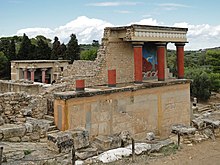
Back Knossos Afrikaans ክኖሦስ Amharic كنوسوس Arabic كنوسوس ARZ Cnosos AST Knoss Azerbaijani Кнос Byelorussian Кнос BE-X-OLD Кносос Bulgarian Cnossos Catalan
Κνωσσός | |
 Reconstructed North Entrance | |
 Map of Crete | |
| Location | Heraklion, Crete, Greece |
|---|---|
| Region | North central coast, 5 km (3.1 mi) southeast of Heraklion |
| Coordinates | 35°17′53″N 25°9′47″E / 35.29806°N 25.16306°E |
| Type | Minoan palace |
| Area | Total inhabited area: 10 km2 (3.9 sq mi). Palace: 14,000 m2 (150,000 sq ft)[1] |
| History | |
| Founded | Settlement around 7000 BC; first palace around 1900 BC |
| Abandoned | Palace abandoned Late Minoan IIIC, 1380–1100 BC |
| Periods | Neolithic to Late Bronze Age |
| Cultures | Minoan, Mycenaean |
| Site notes | |
| Excavation dates | 1900–present |
| Archaeologists | Minos Kalokairinos, Sir Arthur Evans, David George Hogarth, Duncan Mackenzie, Theodore Fyfe, Christian Doll, Piet de Jong, John Davies Evans |
| Condition | Restored and maintained for visitation. |
| Management | 23rd Ephorate of Prehistoric and Classical Antiquities |
| Public access | Yes |
| Website | Hellenic Ministry of Culture and Tourism |
Knossos (pronounced /(kə)ˈnɒsoʊs, -səs/; Ancient Greek: Κνωσσός, romanized: Knōssós, pronounced [knɔː.sós]; Linear B: 𐀒𐀜𐀰 Ko-no-so[2]) is a Bronze Age archaeological site in Crete. The site was a major centre of the Minoan civilization and is known for its association with the Greek myth of Theseus and the minotaur. It is located on the outskirts of Heraklion, and remains a popular tourist destination. Knossos is considered by many to be the oldest city in Europe.[3]
Knossos is dominated by the monumental Palace of Minos. Like other Minoan palaces, this complex of buildings served as a combination religious and administrative centre rather than a royal residence. The earliest parts of the palace were built around 1900 BC in an area that had been used for ritual feasting since the Neolithic. The palace was continually renovated and expanded over the next five centuries until its final destruction around 1350 BC.
The site was first excavated by Minos Kalokairinos in 1877. In 1900, Sir Arthur Evans undertook more extensive excavations which unearthed most of the palace as well as many now-famous artifacts including the Bull-Leaping Fresco, the snake goddess figurines, and numerous Linear B tablets. While Evans is often credited for discovering the Minoan Civilization, his work is controversial in particular for his inaccurate and irreversible reconstructions of architectural remains at the site.
- ^ McEnroe, John C. (2010). Architecture of Minoan Crete: Constructing Identity in the Aegean Bronze Age. Austin: University of Texas Press. p. 50. However, Davaras 1957, p. 5, an official guide book in use in past years, gives the dimensions of the palace as 150 m (490 ft) square, about 20,000 m2 (220,000 sq ft).
- ^ Hooker, J. T. (1991). Linear B: An Introduction. Bristol Classical Press. pp. 71, 50. ISBN 978-0-906515-62-4.
- ^ Whitelaw, Todd (2000). "Beyond the palace: A century of investigation at Europe's oldest city". Bulletin of the Institute of Classical Studies: 223, 226.